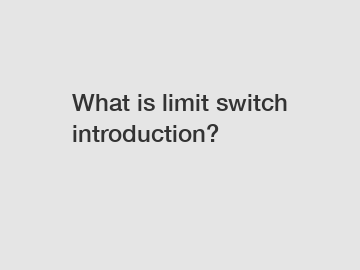Feb. 05, 2024
Electrical Equipment
Definition of Limit Switches.
A limit switch is an electromechanical device that detects the presence or absence of an object within its designated range. It consists of an actuator and contacts that open or close when the object reaches a specific position or limit. When the actuator is triggered, it sends a signal to the system, which can be used to activate or deactivate machinery, control movement, or stop the operation in case of an abnormal condition.
Types of Limit Switches.

There are several types of limit switches available in the market, each designed for specific applications. The most common types include:
1. Levered Limit Switches: These switches use a lever arm to detect the presence or absence of an object. The lever arm is actuated by the movement of the object and triggers the switching mechanism.
2. Plunger Limit Switches: Plunger limit switches utilize a spring-loaded plunger as an actuator. When an object comes into contact with the plunger, it compresses the spring, causing the switch contacts to change state.
3. Rotary Limit Switches: This type of limit switch operates by rotating the actuator. It is commonly used in machinery that requires angular or rotational movement sensing.
Applications of Limit Switches.
Limit switches find application in various industries and environments where the monitoring and control of mechanical positions are critical. Some common applications include:
1. Industrial Automation: Limit switches are extensively used in industrial automation to control the operation of machines and equipment. They ensure precise stopping points, protect against overtravel, and enable automated processes.
2. Robotics: Limit switches are vital in robotics for detecting the position of robot arms, fingers, or grippers. They assist in precise handling, preventing collisions, and establishing safety boundaries.
3. Elevators: In elevators, limit switches control the stopping points, ensuring that the elevators align accurately with each floor and preventing accidents due to overshooting or undershooting.
4. Conveyor Systems: Limit switches are crucial for detecting the presence of objects on conveyor belts. They help in activating or deactivating the conveyor system, ensuring the smooth flow of materials.
Benefits of Limit Switches.
Limit switches offer several advantages that make them an essential component in automated systems. Some key benefits include:
1. Enhanced Safety: Limit switches ensure the safety of personnel and equipment by providing accurate position feedback, preventing overtravel, and stopping the operation when necessary.
2. Improved Efficiency: With precise control over mechanical positions, limit switches help optimize processes, reduce downtime, and increase productivity.
3. Cost Savings: Limit switches help prevent damage to machinery, saving costs associated with repairs, replacements, and unscheduled shutdowns.
4. Versatility: With a wide range of types and designs available, limit switches can be tailored to fit specific application requirements, making them suitable for diverse industries.
In conclusion, limit switches are essential components in automated systems and machinery, providing control and safety features. With various types available, they can be customized to meet specific application needs. The benefits of limit switches, including enhanced safety, improved efficiency, cost savings, and versatility, make them an indispensable part of modern automation. If you have any further questions or need assistance with limit switches, please feel free to contact us.
The company is the world’s best Limit Switch China Supplier, Supply Top-roller Plunger Actuator Limit Switch, Kinds of Micro-switches supplier. We are your one-stop shop for all needs. Our staff are highly-specialized and will help you find the product you need.
If you are interested in sending in a Guest Blogger Submission,welcome to write for us!
All Comments ( 0 )